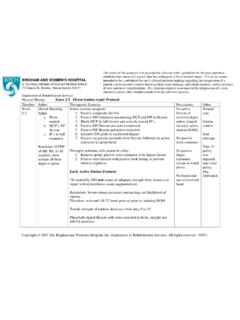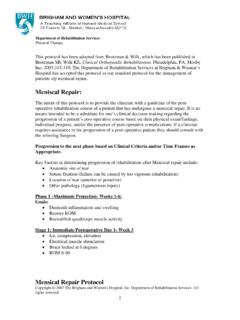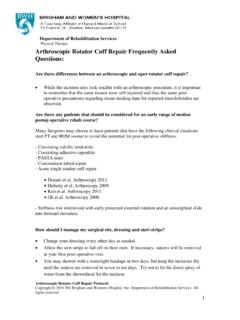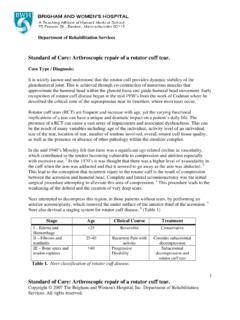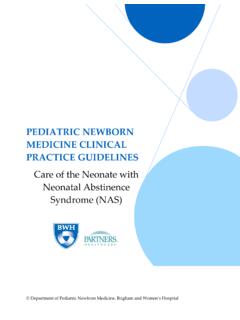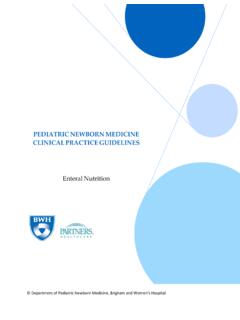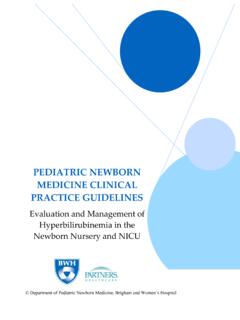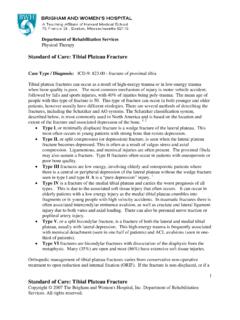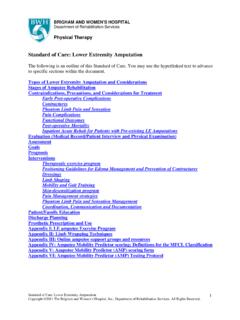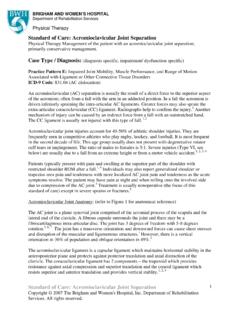Transcription of Protocol: Modified Brostrӧm-Gould Repair for Chronic ...
1 protocol : Modified Brostr m-Gould Repair for Chronic lateral ankle instability Copyright 2017 The Brigham and Women's Hospital, Inc., Department of Rehabilitation Services. All rights reserved 1 Department of Rehabilitation Services Physical Therapy protocol : Modified Brostr m-Gould Repair for Chronic lateral ankle instability ICD 10 Codes: : Other instability , ankle and foot : Sprain of ankle : Sprain of calcaneofibular ligament : Sprain of other ligament of ankle The intent of this protocol is to provide the clinician with a guideline of the post-operative rehabilitation course of a patient who has undergone an anatomical surgical procedure. It is by no means intended to be a substitute for one s clinical decision making regarding the progression of a patient s post-operative course based on their physical exam/findings, individual progress, and/or the presence of post-operative complications.
2 If a clinician requires assistance in the progression of a post-operative patient they should consult with the referring surgeon. The following post-operative rehabilitation protocol was originally authored in 2010, and at that time, was adapted from the protocol used at the Hospital for Special Surgery (HSS), where the Modified Brostrom-Gould procedure is the preferred anatomical surgical procedure for the treatment of lateral ankle instability . Description: This protocol applies to patients following the Gould Modified Bostr m Repair of the Anterior Talo-fibular Ligament (ATFL) and Calcaneal Fibular Ligament (CFL). Rupture of these ligaments is common as a result of diagnoses including but not limited to: Inversion ankle sprains1 Chronic lateral ankle instability (CAI)2 Acute severe lateral ankle ligament injuries3 This protocol serves as a guide for clinical decision-making for physical therapy (PT) management of this patient population at Brigham and Women s Hospital (BWH) Department of Rehab Services.
3 The Brostr m Repair is an anatomic Repair of both the ATFL and CFL, while the Gould Modified Repair includes advancement of the extensor retinaculum to strengthen the The goal of the procedure is to achieve anatomical stability of the talocrural and subtalar joints. Anatomic Repair of the ATFL and CFL is achieved by use of a suture anchor Repair technique. Anchors are typically placed into the cortical bone of the fibula at the anatomical footprint of each ligament respectively. A third anchor can be used to Repair the articular joint capsule. The protocol : Modified Brostr m-Gould Repair for Chronic lateral ankle instability Copyright 2017 The Brigham and Women's Hospital, Inc., Department of Rehabilitation Services. All rights reserved 2 extensor retinaculum is advanced and repaired to the periosteal flap in the Gould Modified procedure.
4 Potential associated lesions can affect progression and healing timelines. These may be noted in an operative report, imaging study or be uncovered during clinical examination and include but are not limited to5: Osteochondral defects Peroneal tendinopathy Sinus tarsi Subtalar instability Impingement Chondromalacia Phase I: Immediate Post-Operative Phase (0-2 weeks) Precautions o Wound Care Avoid direct contact with water for first 7 days post-operatively or until first follow up for suture removal After first week showering is permitted but submersion in water ( bath, pool, hot tub etc.) should be avoided until full wound closure has been achieved o Weight bearing restrictions Likely Non-weight bearing (NWB) with short leg cast or pneumatic walking boot unless otherwise indicated6 o ROM restrictions Avoid AROM/AAROM/PROM into inversion Avoid AROM/AAROM/PROM into plantarflexion Goals o Edema control/reduction o Protect healing tissue ( ankle is likely placed into immobilizing device which may include pneumatic walking boot or Short Leg Cast (SLC)) o Independent transfers and ambulation using appropriate assistive device (especially with weight bearing restrictions) o Prevent secondary deconditioning Physical Therapy Interventions o Proximal lower extremity (LE), upper extremity (UE)
5 And trunk muscle strengthening as indicated o Monitor wound healing and consult with referring MD if signs and symptoms of infection are present o Modalities for pain/edema control ( Game Ready, elevation, ice, etc.) o Aerobic upper body conditioning o Transfer and gait training with optimal assistive device (if applicable) o Identify patient s goal for return to recreational and/or sport specific activities protocol : Modified Brostr m-Gould Repair for Chronic lateral ankle instability Copyright 2017 The Brigham and Women's Hospital, Inc., Department of Rehabilitation Services. All rights reserved 3 Criteria for progression to Phase II o Decreased pain o Decreased edema o Independence with home exercise program o Independence with transfers and ambulation with appropriate weight bearing precaution Phase II: Early Rehabilitation (2-6 weeks) Precautions o Activity Restrictions Limit prolonged standing/walking Avoid driving until: Right leg is no longer in pneumatic walking boot (if right leg is operative side) Able to use right leg effectively to brake in an emergency Patient is no longer using narcotic pain medication Patient feels comfortable and confident in driving ability MD and/or PT have no further concerns with driving ability o Weight bearing restrictions.
6 Likely touch-down weight bearing (TDWB) in pneumatic walking boot or SLC unless otherwise indicated7 o ROM restrictions Limit AROM/AAROM/PROM into eversion to 10 in safe controlled manner6 No inversion AROM/AAROM/PROM Gentle and controlled AROM/AAROM/PROM into plantarflexion6 Goals o Edema control/reduction o Protect healing tissue o Progress weight bearing using appropriate assistive device as indicated (take into account operative technique and associated pathologies) o Prevent secondary deconditioning Physical Therapy Interventions o Proximal LE, UE and trunk muscle strengthening as indicated o Aquatic therapies/Upper body aerobic conditioning o Transfer and gait training with optimal assistive device o Modalities for pain/edema control ( Game Ready, elevation, ice, etc.)
7 O Begin gentle and controlled ROM exercises within post-operative precautions Note: ROM is not equivalent to stretching Stretching should be avoided until phase II o Submaximal ankle isometrics in all directions excluding inversion Criteria for progression to phase II o Decreased pain o Decreased edema o Independence with home exercise program (HEP) o Independence with transfers/ambulation using assistive device (if applicable) protocol : Modified Brostr m-Gould Repair for Chronic lateral ankle instability Copyright 2017 The Brigham and Women's Hospital, Inc., Department of Rehabilitation Services. All rights reserved 4 Phase II: Late Rehabilitation (Approximately 6-10 weeks) Precautions o Weight bearing restrictions Weight bearing as tolerated (WBAT) o ROM restrictions Avoid inversion AROM/AAROM/PROM until week 9 Goals o Progressive protected normalization of gait.
8 After the initial 6 week immobilization in pneumatic walking boot patient will begin transition to protected ankle weight bearing in a commercially available semi-rigid stirrup orthotic or independent ambulation without bracing o Edema control and patient education regarding skin checks with use of bracing o Pain reduction o Improve conditioning o Prevention of scar adhesion and myofascial restriction o Restore AROM o Begin controlled strengthening exercises o Improve balance Physical therapy interventions: o Progressive weight bearing as tolerated o Gait training including use of appropriate assistive device and/or ankle orthotic as indicated o AROM/AAROM/PROM exercises as indicated o Joint mobilizations as identified by surgeon, adhering to identified precautions and avoiding the tensioning of the CFL and ATFL o Protected ankle strengthening exercises o Gastrocnemius and soleus stretches as indicated o Soft tissue mobilization as indicated o Continued proximal muscle strengthening activities within precautions o Proprioception activities within surgical precautions o Supplemental strengthening including leg press.
9 Bicycle and knee extensions o Aquatic therapies/Upper body aerobic conditioning Guidelines for progression to Phase III6 o Restoration of symmetrical gait pattern without use of assistive device o Strength within 90% of unaffected side (using isokinetic or isometric strength measures Biodex, hand held dynamometry, manual muscle testing, etc.) Phase III: Return to Function (Approximately 10-14 weeks) Precautions o Activity restrictions Return to plyometric activities (including jogging, jumping, hopping etc.) should not occur until 11 weeks post-operative and patient can perform 25 unilateral heel raises without pain or difficulty6 protocol : Modified Brostr m-Gould Repair for Chronic lateral ankle instability Copyright 2017 The Brigham and Women's Hospital, Inc.
10 , Department of Rehabilitation Services. All rights reserved 5 Goals o Restore full AROM no later than week 12 o Reduction of post-activity edema o Normalize gait pattern on stable/unstable surfaces o Return to step through pattern for stair ascent/descent (if applicable) o Strengthening of ankle muscle groups o Restore functional strength Physical Therapy Interventions o AROM/AAROM/PROM exercises as indicated o Modalities as indicated for edema/pain control o Unilateral weight bearing ankle strength exercises o Bilateral and unilateral weight bearing and proprioceptive and balance exercises o Functional lower kinetic chain strength exercises Guidelines for progression to Phase IV6 o Return of 90% function of the ankle compared with unaffected side measured with assessments that include but are not limited to Single leg hop for distance8 Triple hop for distance9 Star excursion balance test10 Y-Balance Test11 Phase IV.
